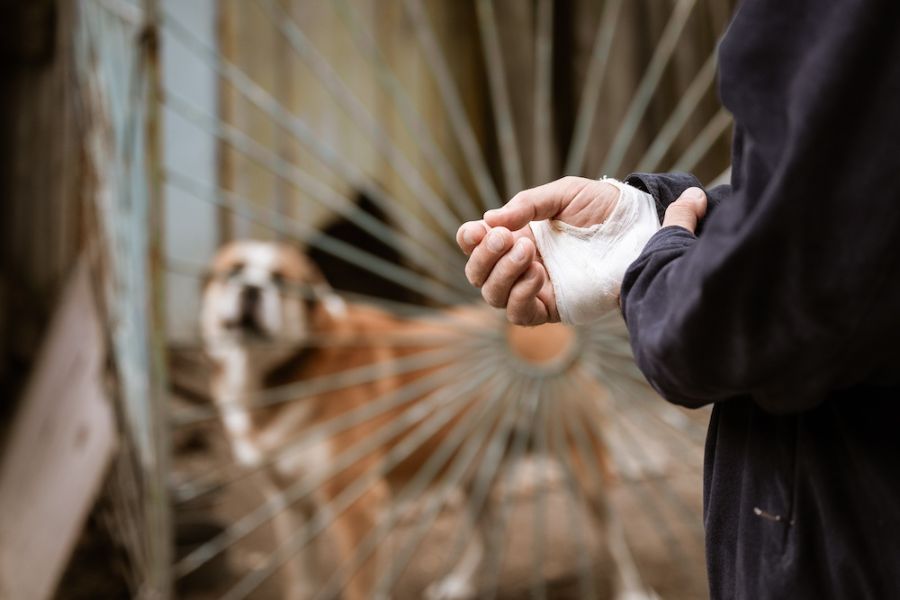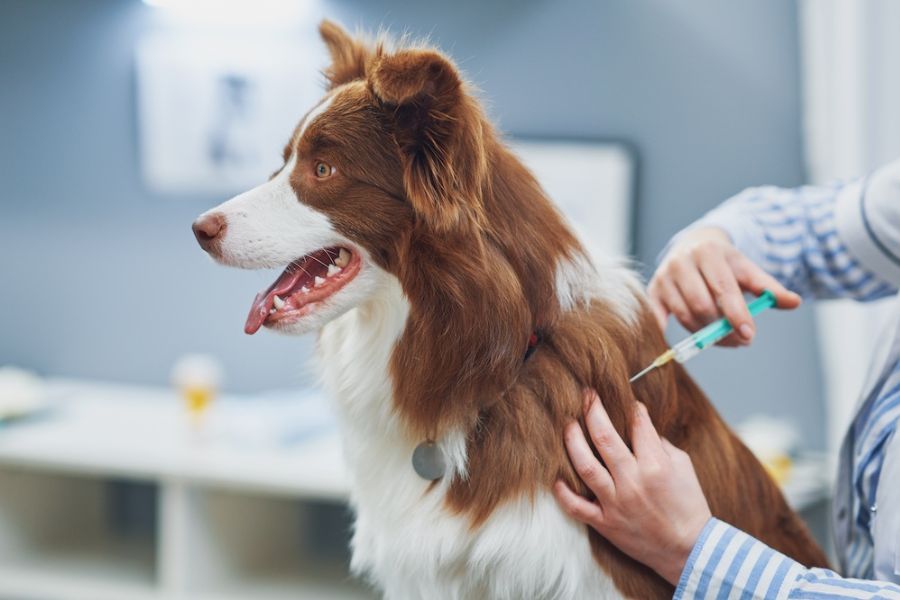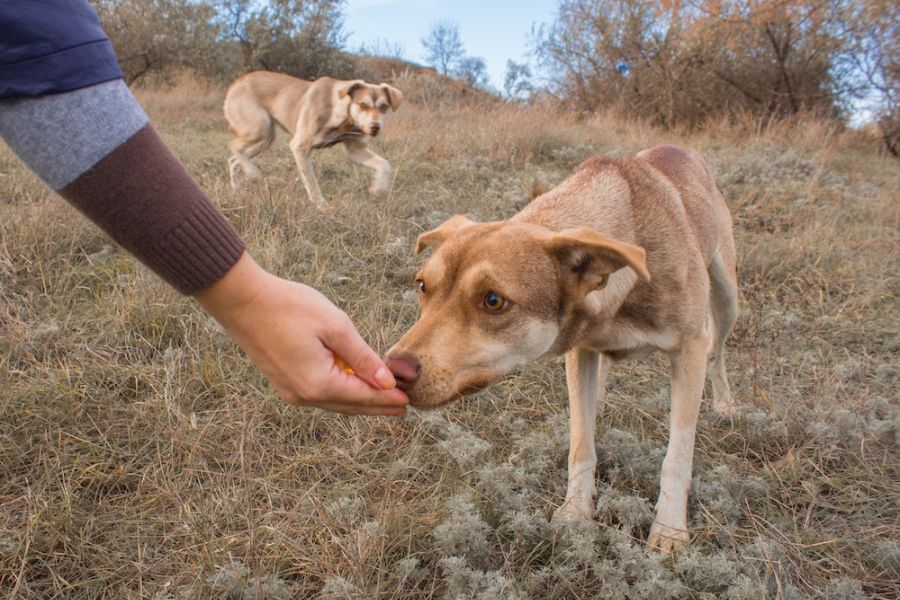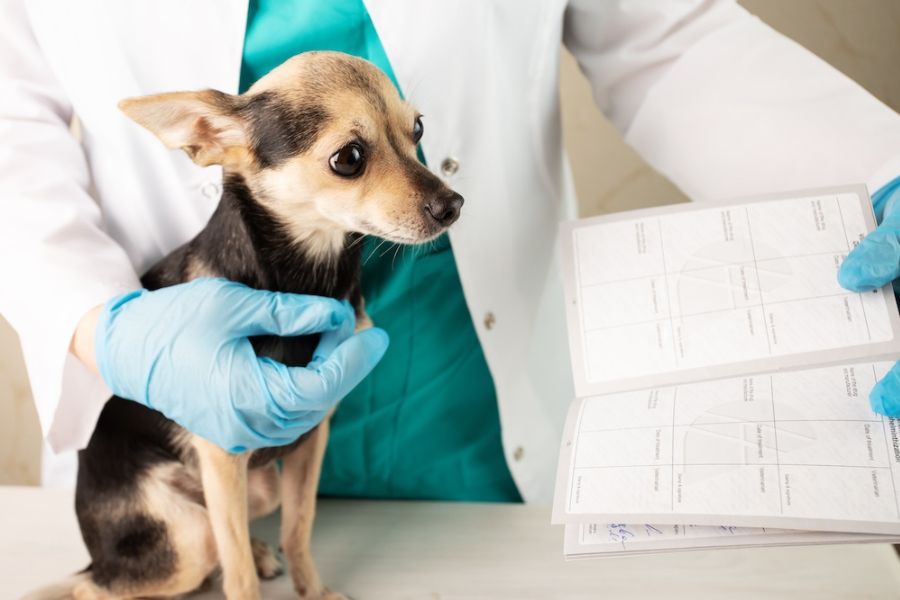- World Rabies Day
- What is rabies
- Which animals transmit rabies?
- How does rabies manifest itself?
- How to tell if an animal has rabies?
- Why is it important to know about rabies?
- Rabies: what is the right prevention for our pet?
- Does rabies exist in Italy?
- Are there other diseases transmissible from animals to humans?
- Which diseases can dogs transmit to humans?
- Rabies vaccine and travel: what should we do?
- How to prevent diseases transmitted by animals?

Rabies is a terrible infection capable of affecting all mammals, and it is among the oldest diseases of which we have record.
Unfortunately, the main cause of death from rabies in people is transmission by our dearest friends: dogs. But the good news is that this devastating disease is today 100% preventable.
To increase knowledge and awareness on this subject, in 2007 World Rabies Day was established, celebrated every year on September 28.
Let’s see together what the objectives of World Rabies Day are and delve into the characteristics of this disease, to understand how each of us can do our part to prevent it and try to eradicate it from the planet, so that no living being ever has to suffer or even die because of it.
World Rabies Day
World Rabies Day, is today promoted by GARC, the Global alliance for rabies control, the main international non-profit organization that provides scientifically based information about rabies worldwide.
At the same time, in the United Kingdom, the Alliance for rabies control is active, a charity that shares GARC’s mission and is engaged in organizing awareness-raising activities so that this terrible disease can disappear from the face of the earth.
World Rabies Day is an event that we can consider as the tip of the iceberg of the work that GARC carries out daily, working with governments, stakeholders, and local partners to raise awareness about rabies, support and push for political and financial commitment, so that this terrible plague stops claiming victims among people and our beloved animals.
The first edition of World Rabies Day dates back to 2007 and involved 400,000 people from 74 different countries around the world.
The awareness-raising events then led to the vaccination of hundreds of thousands of animals, the adoption of health regulations, and the implementation of practices that are now widely used around the world to fight rabies.

Rabies: a terrible disease that can unfortunately affect our beloved life companions.
What is rabies
- Rabies
- Rabies, or improperly called hydrophobia, is the infectious disease caused by the Rhabdovirus. It affects mammals (dogs, wolves, foxes, cats, and bats) with an outcome that is almost always fatal, and it can be transmitted to humans through a bite or contact.
Taken from this entry of the Italian Encyclopedia Treccani.
Rabies is therefore a viral disease, caused by viruses that belong to the genus Lyssavirus, family Rhabdoviridae, order Mononegavirales.
As explained in a specific section dedicated to rabies on the website of the Italian Ministry of Health:
“All lyssaviruses are considered responsible for acute fatal encephalomyelitis with indistinguishable symptoms. The Lyssavirus genus includes 16 viral species, plus two whose taxonomy still remains uncertain (Walker et al., 2018).”
Rabies unfortunately affects domestic and wild animals and can be transmitted to humans, as well as to other animals, through the saliva of infected specimens.
The most common cases are bites, scratches, and contact with mucous membranes, even if they are intact.

To protect our four-legged hearts and ourselves from rabies, it is essential to always monitor their state of health.
Which animals transmit rabies?
Potentially, rabies can affect all warm-blooded animals.
Currently, the most affected by this terrible infection are the fox in the so-called “sylvatic cycle” and our beloved dog in what is called the “urban cycle.”
In the urban cycle, in fact, we find dogs, especially if they are stray or live in semi-wild conditions, perhaps in forests or woods. Cats, although to a lesser extent, are also affected.
As for the sylvatic cycle, the animal currently most in the spotlight is the fox, but rabies can also be transmitted by wolves, jackals, coyotes, as well as by bats and rodents.
How does rabies manifest itself?
Rabies develops encephalitis, with a fatal course both for people and for animals. Data shows that in the case of rabies, death is certain in 90% of cases.
Unfortunately, the first symptoms are not very specific and, consequently, can be mistaken for other health problems, because they involve gastrointestinal discomfort and respiratory issues.
But later, the disease can evolve into two forms:
- In 75% of cases, “furious” rabies develops, which is the majority of cases. In this phase, psychomotor disorders appear, defined by the Italian ISS, (Istituto Superiore di Sanità) as “excitatory.”
In this case, very serious symptoms appear, such as loss of sense of direction and excessive hyperactivity, with peaks of true fury.
Animals may salivate excessively, a condition that unfortunately favors contagion, and as the infection progresses, it causes progressive paralysis of the muscles, degenerating into coma and finally death.
- In 25% of cases, “paralytic” rabies develops, with progressive paralysis that occurs without manifestations of aggression or fury.
How to tell if an animal has rabies?
As can be inferred from what has been described so far, unfortunately the first symptoms of rabies are generic and can be associated with other diseases.
Paying close attention to behavioral disorders is extremely important to understand if the animal may have contracted rabies, especially if a docile specimen becomes particularly aggressive.
Another aspect to consider is an alteration in phonation, that is, in their vocal sounds.
If unfortunately a little heart were to show these symptoms, as well as if we were to notice them in wild animals, it is essential to immediately call a trusted veterinarian to explain the situation.
And, of course, avoid any contact with the animal.
Why is it important to know about rabies?
World Rabies Day aims to make as many people as possible around the world aware of the nature of this tragic disease in order to prevent it.
We have seen its extremely high mortality rate, which, however, can be defeated if the whole world committed to eradicating it.
The mantra, in this case, is also stated by the promoters of World Rabies Day: “rabies prevention begins with the owner of an animal.”
In fact, there is a handbook that contains simple yet vital guidelines to protect our pets, as well as ourselves, from rabies:
- Protect yourself, your animal, and your community by vaccinating your animals.
- Avoid contact with stray or wild animals.
- If you have been bitten, wash the wounds with water and soap and immediately contact a doctor.
- If your animal has been bitten, immediately consult a veterinarian.
- Timely and appropriate treatments after bites and before the disease develops can, in fact, stop the infection and prevent the disease both in humans and in animals.”

Vaccination is, today, the only effective tool in our hands to fight rabies.
Rabies: what is the right prevention for our pet?
The only currently known tool to fight rabies and ensure that this disease can disappear from the planet is vaccination, which applies to both animals and people.
As for people, professionals who are at risk undergo preventive vaccination. These include veterinarians, forest rangers, and other professional figures who work in contact with animals.
There are also post-exposure vaccination solutions, which are administered if a person has come into contact with risky situations, such as being attacked by a suspected animal.
As for our pets, the Veneto Region portal offers various information on rabies vaccines for domestic animals. However, each region or state has its own reference websites.
The rabies vaccine contains the inactivated virus and is used as prevention, but also as treatment if, unfortunately, the pet comes into contact with the infection.
Preventive treatment, that is, the actual rabies vaccine, is administered with two injections one month apart and another after one year. There are also formulations that provide for closer administration, should faster immunization be necessary.
If domestic animals live in risk areas or are potentially exposed to dangerous factors (for example, they live in a house near a forest where rabies cases have occurred), a booster of the vaccine can be given.
Naturally, our advice is first of all to ask your trusted veterinarian for information about it.
Does rabies exist in Italy?
According to the Istituto Zooprofilattico Sperimentale delle Venezie, the control body regarding animal health, our nation is fortunately currently free from this disease, as can be read in this report on the epidemiological situation of rabies in Italy.
The institute reports that, after more than a decade in which our country was rabies-free, from 2008 to 2013 some cases occurred in the northeast, particularly in Friuli Venezia Giulia, in the areas of Trento, Bolzano, and Belluno.
Following an oral vaccination campaign for foxes, the disease was eradicated from the territory, and in 2013 Italy regained rabies-free status, but it is essential not to let our guard down.
In which countries of the world is rabies present?
Rabies is, unfortunately, still present today in several countries around the world, and those most at risk are the ones with large forests, such as Russia and Asian countries.
In 2024, for example, a case of rabies transmitted to a human was unfortunately confirmed in the state of Timor Leste, which borders Indonesia, as reported in this section of news and research from Eurosurveillance.
For updates, however, we recommend referring directly to Europe’s journal on infectious disease surveillance, epidemiology, prevention and control, which monitors the epidemiological situation at an international level.

Keywords: attention, care, and control, especially if pets live in natural environments, for example near forests.
Are there other diseases transmissible from animals to humans?
The diseases that are transmitted from animals to people are called zoonoses, and the responsible agents are different parasites, fungi, bacteria, viruses, and other biological entities.
These diseases can be transmitted through contact with an infected animal, perhaps through:
- direct contact of a susceptible host with an infected animal (for example, contact with saliva, blood, urine, feces, or other body fluids)
- indirect transmission through contact with soil or objects contaminated by zoonotic agents
- vector transmission through mosquitoes, ticks, fleas, and lice that act as vectors for some zoonotic agents
- transmission through contaminated water or food (for example, food produced from infected animals or contaminated during the stages of production, preparation, or processing).
According to Efsa, the European Food Safety Authority, between one-third and half of infectious diseases that affect people have a zoonotic origin, that is, transmitted from animals to humans.
The major division is between foodborne and non-foodborne zoonotic diseases. The former include viruses such as Hepatitis A and Rotavirus, parasites such as Giardia, and bacteria such as Salmonella and Escherichia Coli.
Among the non-foodborne diseases are Malaria and West Nile Fever, transmitted by mosquitoes, Lyme disease from ticks, and Avian Influenza from birds.
Which diseases can dogs transmit to humans?
World Rabies Day is an opportunity to learn about this tragic infection, as well as to understand if there are other diseases that our furry friends can unfortunately transmit to humans.
First of all, it is very important to make a clarification: zoonoses are transmitted by pathogenic organisms such as viruses, bacteria, fungi… in other words, they are the actual cause of the disease.
In some cases, the dog, just like other domestic and non-domestic animals, becomes a vehicle of the disease: people come into contact with him and risk becoming infected.
The main ones are:
- Dermatophytosis (Ringworm) and Scabies (Mange): these are skin mycoses that can be transmitted through direct or indirect contact with the infected animal.
- Hydatidosis: this is a disease caused by cysts containing the larvae of the flatworm, the tapeworm. Infection can occur if a person accidentally ingests the larvae present in dog feces. This may seem hardly possible, if not even impossible, but for example, if the dog’s fur comes into contact with feces and a person touches it, then accidentally brings their hands to their mouth, infection can occur.
- Toxocariasis or Visceral Larva Migrans: this is caused by intestinal parasites and transmission can occur as in the case of Hydatidosis, that is, through contact with infected dog feces.
- Cutaneous Larva Migrans or Verminous Dermatitis: this too is caused by a parasite, and humans can come into contact with it through soil contaminated by infected feces. Children are particularly at risk, as they tend to play with dirt and sand.
- Leishmaniasis: this unfortunately well-known disease is widespread and is a protozoan infection that can be transmitted from dog to human and also vice versa, due to the bite of a small blood-sucking insect called the sandfly.
- Salmonellosis: this is a foodborne zoonosis, but in some cases it can also be transmitted directly by dogs, as well as by other animals.
- Giardiasis: Giardia is an infection that can be transmitted when coming into contact with contaminated water, and the dog can be a vehicle, especially in conditions of poor hygiene.
- Dipylidium Caninum: this is a flatworm that can unfortunately become an unwanted guest in the dog’s intestine, and humans can contract the infection if, incidentally, they come into contact with an infested dog flea. By its nature, transmission is rare.
- Fleas, lice, and ticks: finally, it is necessary to mention the most unwanted guests of our pets, lice, fleas, and ticks, a topic we have covered in this article on our blog. Lice are “host-specific parasites”, meaning they do not pass to humans, who are attacked by lice that prefer humans. This is not the case for fleas and ticks, which make no distinction and can become human parasites by biting. The bite itself may not be so dangerous, but it is important to remember that these parasites can be carriers of serious diseases, such as Lyme disease in the case of ticks.

If we travel with our little sweethearts, it is very important for their and our protection to find out about the vaccinations required in different countries.
Rabies vaccine and travel: what should we do?
To travel in the European Union, furry friends must have a passport, which is issued by the veterinary services of the local health authority where they reside.
To obtain this document, the rabies vaccine is mandatory and there are some important conditions to be met:
- The vaccination must have been given to an animal that is at least 12 weeks old (3 months);
- The date on which the vaccine is administered must be after the date on which the microchip was applied;
- At least 21 days must have passed since the first administration of the vaccine (this is the time needed for it to be effective).
Specific information on the rabies vaccination required for traveling in Europe is contained in Annex III of Regulation (EU) 576/2013. The European Commission specifies that there are exemptions for puppies, which can be consulted on this page.

Passed! How good our four-legged love is, now they can travel around the world!
Where is the rabies vaccine given?
Vaccination can be done by your trusted veterinarian, as well as at the clinics of the local health authorities (ASL) that provide this type of healthcare service.
And if the dog travels to a non-EU country?
If the travel destination is a non-EU country, the European passport is not enough; the international certificate is required.
Be careful, because to return to a country that is part of the European Union from a non-European country, the passport is still required. Institutions therefore recommend having both documents.
It should also be considered that every country in the world has different rules, and some do not even allow furry friends to enter their borders.
The Ministry of Health recommends the following: “It is advisable to obtain the necessary information by contacting the embassy in Italy of the third country or by directly contacting the veterinary service of the relevant local health authority (ASL) for the possible issuance of the necessary health certification.”
On this page, you can find all the information, along with the list of individual countries.

To fight rabies and many other diseases, it is essential to take care of the hygiene of our furry friends.
How to prevent diseases transmitted by animals?
On the occasion of World Rabies Day, we have seen that the main tool to fight this tragedy is the vaccine.
The advice, even if it may seem obvious, is to ask your trusted veterinarian for specific information to understand how to proceed with vaccination.
As for all other transmissible diseases, including rabies, we have summarized 5 points that make it possible to prevent them.
These are simple but very important tips to ensure the well-being of our pets and to prevent diseases from spreading, afflicting them among themselves and becoming potential dangers to people’s lives.
- Feed pets with care and attention, avoiding raw meat and always choosing high-quality, controlled, and certified products;
- Keep our furry friends always clean with specific products for baths and showers. This is essential to prevent attacks from parasites and dangerous pathogenic organisms;
- Keep the places where they live daily clean: from kennels to cushions, hygiene is essential to minimize infections and contamination from parasites;
- Use appropriate antiparasitics and strengthen their action with natural repellent products, especially when we take walks outdoors;
- Avoid going to potentially dangerous places with our little sweethearts, such as areas with a lot of stagnant water or a high density of parasites (for example, certain mountain areas where the presence of ticks or wild animals is considerable).
One last piece of advice, very much connected to World Rabies Day, is to try to spread information and guidance, because this disease, as well as many other illnesses transmitted from animals to humans, can be fought with a very powerful tool: information, which allows us to make the right choices for people and for our beloved pets.
Not by chance, as we have seen, the mantra of World Rabies Day is: “rabies prevention starts with the owner of an animal”: Change therefore begins with us.







